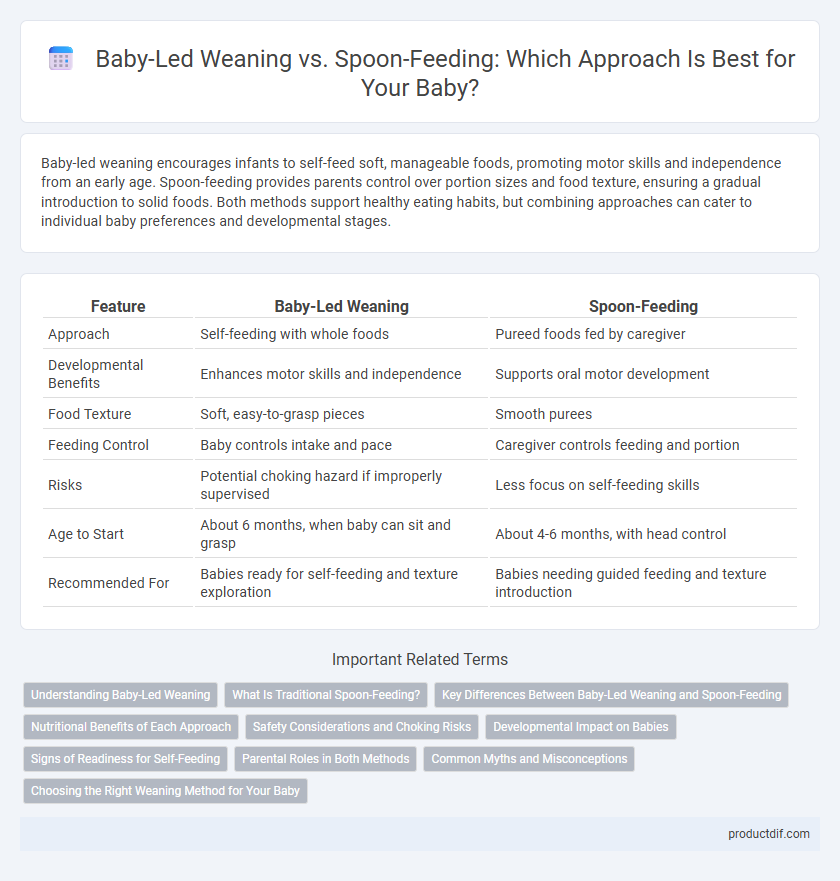Baby-led weaning encourages infants to self-feed soft, manageable foods, promoting motor skills and independence from an early age. Spoon-feeding provides parents control over portion sizes and food texture, ensuring a gradual introduction to solid foods. Both methods support healthy eating habits, but combining approaches can cater to individual baby preferences and developmental stages.
Table of Comparison
| Feature | Baby-Led Weaning | Spoon-Feeding |
|---|---|---|
| Approach | Self-feeding with whole foods | Pureed foods fed by caregiver |
| Developmental Benefits | Enhances motor skills and independence | Supports oral motor development |
| Food Texture | Soft, easy-to-grasp pieces | Smooth purees |
| Feeding Control | Baby controls intake and pace | Caregiver controls feeding and portion |
| Risks | Potential choking hazard if improperly supervised | Less focus on self-feeding skills |
| Age to Start | About 6 months, when baby can sit and grasp | About 4-6 months, with head control |
| Recommended For | Babies ready for self-feeding and texture exploration | Babies needing guided feeding and texture introduction |
Understanding Baby-Led Weaning
Baby-led weaning encourages infants to self-feed solid foods, promoting motor skill development and independence by allowing them to explore textures and tastes at their own pace. This approach contrasts with traditional spoon-feeding, where parents control the food type and feeding pace, possibly limiting the baby's ability to regulate hunger and develop chewing skills. Research indicates that baby-led weaning can foster better eating habits and reduce picky eating by empowering babies to make food choices early on.
What Is Traditional Spoon-Feeding?
Traditional spoon-feeding involves parents gradually introducing pureed or mashed foods to babies using a spoon, typically starting around six months of age. This method allows caregivers to control the texture and portion size, ensuring the baby's nutritional needs are met while minimizing choking risks. It emphasizes slow introduction of single-ingredient foods to monitor for allergies and digestive tolerance during early complementary feeding stages.
Key Differences Between Baby-Led Weaning and Spoon-Feeding
Baby-led weaning encourages infants to self-feed solid foods directly, promoting motor skills and independence, while spoon-feeding involves parents introducing pureed foods for controlled intake. Key differences include texture exposure, feeding pace, and developmental focus, with baby-led weaning emphasizing whole foods and sensory exploration versus spoon-feeding's gradual texture progression. Nutritional intake monitoring and potential choking hazards differ, making parental supervision and appropriate food choices essential for both methods.
Nutritional Benefits of Each Approach
Baby-led weaning encourages self-feeding with whole foods, promoting the intake of a diverse range of textures and flavors that support motor skills and independent eating habits. Spoon-feeding allows precise control over portion sizes and nutrient-rich purees, ensuring babies receive essential vitamins and minerals tailored to their developmental needs. Both methods contribute uniquely to balanced nutrition, with baby-led weaning fostering autonomy and varied nutrient exposure, while spoon-feeding guarantees targeted nutritional intake.
Safety Considerations and Choking Risks
Baby-led weaning encourages self-feeding with age-appropriate, soft, and easily dissolvable foods to reduce choking hazards; however, constant supervision and offering suitably sized pieces remain critical for safety. Spoon-feeding purees allows parents to control texture and portion size, minimizing choking risks but requiring careful attention to food progression and responsiveness to the baby's cues. Both methods necessitate creating a safe eating environment and awareness of potential choking signs to ensure the baby's wellbeing during the transition to solid foods.
Developmental Impact on Babies
Baby-led weaning promotes fine motor skills, hand-eye coordination, and encourages self-regulation in eating by allowing infants to explore textures and flavors at their own pace. Spoon-feeding can support calorie and nutrient intake but may limit sensory and motor development opportunities compared to self-feeding methods. Research indicates that babies engaged in baby-led weaning often develop stronger oral motor skills and exhibit better acceptance of varied foods.
Signs of Readiness for Self-Feeding
Signs of readiness for self-feeding in baby-led weaning include the ability to sit up unsupported, good hand-eye coordination, and an interest in grasping and exploring food. In spoon-feeding, parents look for similar developmental milestones such as head control and the absence of a strong tongue-thrust reflex to prevent food expulsion. Recognizing these signs ensures a safe and effective transition to solid foods, supporting the baby's motor skills and autonomy.
Parental Roles in Both Methods
Parental roles in baby-led weaning emphasize guiding safe exploration and providing diverse, nutritious foods, fostering independence and self-regulation in infants. In spoon-feeding, parents have a more hands-on role, controlling portion size and texture while closely monitoring intake to ensure balanced nutrition. Both methods require attentive supervision and responsive interaction to support healthy eating habits and development.
Common Myths and Misconceptions
Baby-led weaning is often misunderstood as risky choking hazards, yet studies show it encourages self-regulation and reduces gag reflex sensitivity. Spoon-feeding is commonly believed to be the only safe method, but research indicates delayed oral motor development compared to baby-led approaches. Myths about nutritional deficiencies in baby-led weaning are largely unfounded, as babies naturally explore a variety of textures and flavors, promoting diverse nutrient intake.
Choosing the Right Weaning Method for Your Baby
Choosing the right weaning method for your baby involves understanding the benefits of baby-led weaning and traditional spoon-feeding. Baby-led weaning encourages self-feeding and motor skill development by allowing babies to explore whole foods at their own pace, while spoon-feeding ensures controlled portion sizes and gradual introduction to textures. Considering your baby's readiness, temperament, and nutritional needs will help determine the most suitable approach to support healthy eating habits and growth.
Baby-led weaning vs spoon-feeding Infographic

 productdif.com
productdif.com